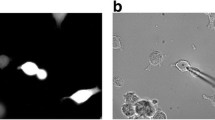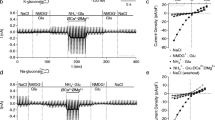Summary
Cadmium ion (Cd++) was found not to inhibit active sodium transport across the isolated frog skin when added in 10−3 m concentration to the basal-lateral surface. The same Cd++ concentration similarly had no effect on Na+ transport across the isolated epithelial cell layer from the frog skin, although this dose of Cd++ did inhibit Na+ transport across the frog urinary bladder and large intestine. When 10−3 m Cd++ was added to the apical surface of the isolated frog skin or to the isolated epithelial cells from the frog skin, sodium transport was reversibly stimulated, in contrast to the irreversible inhibition noted above. If equimolar cysteine was added with Cd++ to the apical surface of the skin, however, active Na+ transport was irreversibly inhibited. In conjunction with the inhibition produced by equimolar Cd++ and cysteine, isotopic Cd++ permeation into the tissue was three times higher when added with cysteine than in the absence of cysteine. Thus, the effects of Cd++ on epithelial Na+ transport is variable according to the epithelium studied and the presence of potential carrier molecules.
Similar content being viewed by others
References
Bentley, P.J. 1960. The effects of vasopressin on the short-circuit current across the wall of the isolated bladder of the toad,Bufo marinus.J. Endocrinol. 21:161
Cofré, G., Crabbé, J. 1967. Active sodium transport by the colon ofBufo marinus: Stimulation by aldosterone and antidiuretic hormone.J. Physiol. (London)188:177
Dixon, W.J., Massey, F.J. 1957. Introduction to statistical analysis. (2nd ed.) McGraw-Hill, New York
Erlij, D. 1971. Salt transport across isolated frog skin.Phil. Trans. R. Soc. London B. 262:153
Gonick, H.C. 1978. Trace metals and the kidney.Mineral Electrolyte Metab.1:107
Gonick, H.C., Indraprasit, S., Neustein, H., Rosen, V. 1975. Cadmium induced Fanconi syndrome.In: Biochemical Aspects of Renal Function. S. Angielski and U. Dubach, editors. pp. 111–118. Huber, Bern
Gunn, S.A., Gould, T.C., Anderson, W.A.D. 1968. Selectivity of organ response to cadmium injury and various protective measures.J. Pathol. Bacteriol. 96:89
Hayashi, H., Takada, M., Arita, A. 1977. Effects of cadmium on the active transport of sodium by the abdominal skin of the bullfrogRana catesbiana.Jpn. J. Physiol. 27:337
Hillyard, S.D., Gonick, H.C. 1976. Effects of Cd++ on short-circuit current across epithelial membranes. I. Interactions with Ca++ and vasopressin on frog skin.J. Membrane Biol. 26:109
Linderholm, H. 1952. Active transport of ions through the frog skin with special reference to the action of certain diuretics.Acta Physiol. Scand 27 (Suppl. 97):1
Lodin, Z., Janacek, K., Muller, J. 1963. The localization and effects of mercury bound by the surviving frog skin.J. Cell. Comp. Physiol. 62:215
Mustafa, M.G., Cross, C.E., Tyler, W.S. 1971. Interference of cadmium with oxidative metabolism of alveolar macrophages.Arch. Int. Med. 137:1050
Nordberg, G.F., Royer, R.A., Nordberg, M. 1975. Comparative toxicity of cadmiummetallothionein and cadmium chloride on mouse kidney.Arch. Pathol. 99:192
Rifkin, R.J. 1965.In vitro inhibition of Na+−K+ and Mg2+, ATPases by mono, di, and trivalent cations.Proc. Soc. Exp. Biol. Med. 120:802
Siegel, G.J., Tormay, A., Candia, O.A. 1975. Microsomal (Na+−K+)-activated ATPase from frog skin epithelium. Cation activations and some effects of inhibitors.Biochim. Biophys. Acta 389:557
Steinbach, H.B. 1933. The electrical potential difference across living frog skin.J. Cell. Comp. Physiol. 55:1
Ussing, H.H., Zerahn, K. 1951. Active transport of sodium as the source of electric current in the short-circuited, isolated frog skin.Acta Physiol Scand. 23:110
Vander, A.J. 1962. Effect of cadmium on renal tubular sodium reabsorption.Am. J. Physiol. 203:1
Webb, M. 1972. Binding of cadmium ions by rat liver and kidney.Biochem. Pharmacol. 21:2757
Author information
Authors and Affiliations
Rights and permissions
About this article
Cite this article
Hillyard, S.D., Sera, R. & Gonick, H.C. Effects of Cd++ on short-circuit current across epithelial membranes. J. Membrain Biol. 46, 283–294 (1979). https://doi.org/10.1007/BF01868751
Received:
Revised:
Issue Date:
DOI: https://doi.org/10.1007/BF01868751




